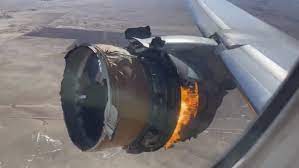|
EXAMPLES OF CLOSE-CALL OCEAN DITCHINGS OF 2-ENGINE AIRLINERS


-------------------------------------------------------
***At least on paper (ETOPS), a 2-engine airliner should be able to operate indefinitely with only one engine running -
(Fuel permitting, of course)
**But, there are events, recently occurring - United Airlines Flights #1175 and #328, and many others, which call into question whether or not this
single-engine flight capability can be depended upon for an extended time and distance.
** Considering the increasing number of recent airliner engine failures, and, when hundreds of passenger lives are at stake, this kind of uncertainty, as to the 1-engine flight capablilty of an airliner, having only 2 engines, is, in my opinion, unacceptable.
**FOR EXAMPLE --
** Event #1 - - An engine-failure/fan-blade failure event recently occurred on a Hawaii-bound United Airlines 2-engine Boeing 777 - (Flt. #1175), which eliminated any false beliefs in the actual single-engine flight capability of a 2-engine airliner, when operating with only 1 engine.
** On this ETOPS certified United Airlines flight #1175, the unexpected and extreme "aerodynamic drag", caused by a large portion of the engine cover which remained partially attached to the airplane after the explosive engine/fan-blade failure, damage to the airframe caused by flying engine parts, which caused intense vibration, and, other un-anticipated problems, resulted in this airliner being unable to maintain altitude with only 1 operating engine.
** (See -- 54 minute YouTube video "Captain Benham UAL#1175 Fan Blade Out INTERVIEW" a shocking and eye-opening video in which Captain
Christopher Benham describes how, after the failure of the right engine, he was unable to maintain altitude with the only remaining engine, and the difficultly he had in controlling this disabled aircraft, and, the necessity of having to brief the passengers on the possibility of having to ditch this airplane, with 381 people aboard, including many children and infants, into the Pacific Ocean.
- - - - - - - - - - (Can anyone imagine this happening ?)
*** Fortunately for everyone aboard UAL #1175, the airplane was only 130 miles (30 minutes) from the Hawaii when the engine-failure occurred, and, was able to make a 1-engine assisted "glide" to the Honolulu Airport.
*** There can be absolutely no doubt, that, had the engine failure, which occured on UAL Flt. #1175, happened only a few minutes earlier, when farther away from Honolulu, this airplane, carrying 381 people, because it was unable to maintain altitude with only 1 operating engine, would have been forced to ditch into the ocean, which would have made this incident the worst 1 airplane disaster in the history of aviation.
**These statements, by Captain Benham, completely obliterate the entire 2-engine airliner over-ocean ETOPS sham, (The dubious FAA program which enabled the use of these dangerous 2-engine airliners on extended over-water flights, as previously described.).
*** The UAL #1175 engine failure incident was an extremely close-call which placed the lives of the passengers and crew of this 2-engine airplane in extreme danger.
***Obviously, an additional 1 or 2 engines, as was required in the past, would have substantially increased the chances of this airplane staying in
the air, and making it safely to a much farther away airport.
** Event #2 - During the recent engine failure event which occurred at Denver (UAL Flt. #328 - also, a 2-engine Boeing 777), not only did all the resulting negative events, as described above, occur, but, in addition, the imbalance in the failed engine, caused by the missing fan-blades, caused unexpected vibration, and, along with the considerable drag, caused by the "Windmilling" of the failed engine, also placed the airplane in an unexpected high-drag high-vibration situation possibility not anticipated during design and certification. (Essentially the same situation as the above described incident)
 UAL #328 engine-failure // Denver
UAL #328 engine-failure // Denver
** Fortunately for the passengers and crew aboard UAL Flt. #328, this Hawaii-bound airliner was very close to an airport when the engine failed, and, was not over the remoteness of the vast Pacific Ocean, and, was not 1250 miles, and, over 5 hours flying time, from the nearest land, when this catastrophic engine failure occurred.
***An additional 1 or 2 engines would have significantly increased the chances of a safe ending for this flight had this engine failure occurred
3 hours into the flight when the airplane was over 1200 over-ocean miles from the closest land.
***I submit that these incidents, and many others, were "Extremely close calls", and put the passengers and crews aboard these airliners in extreme
and unnecessary danger in order for the airlines to save money on fuel.
xxx This terrifing situation could never have happened with a 4-engine airliner before the airline lobby "Pressured" the FAA to
create ETOPS.
***NOTE: Averaged over the last eight months, American Airlines has had planes experience three engine failures per month - far more than any other
domestic airline.
***During that eight-month period, FAA records showed American had 23 failures, Delta had 17, United 15, US Airways 10, Continental 10,
Southwest 7, and Northwest 7.
***Fortunately, these large passenger-filled airliners were not mid-ocean, and were not many hours, and many hundreds of miles from land, when
these engine failures occurred. .
Return to Homepage
|